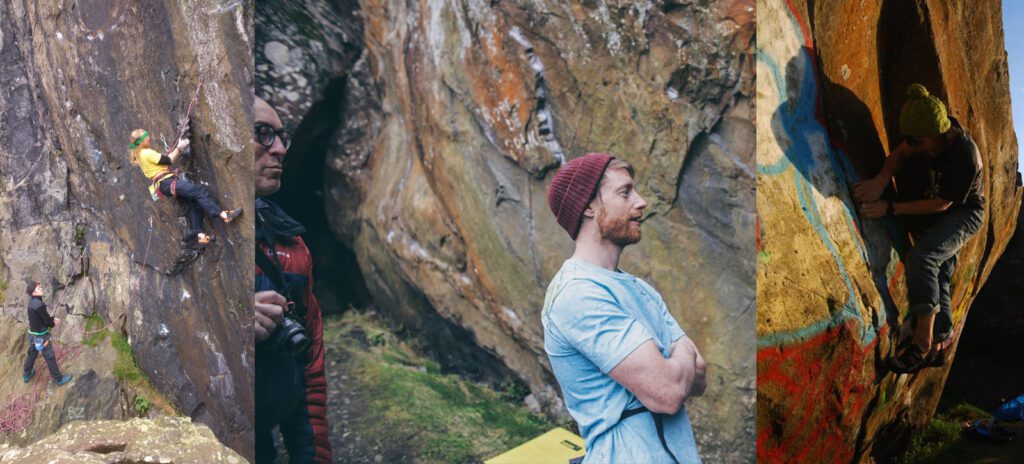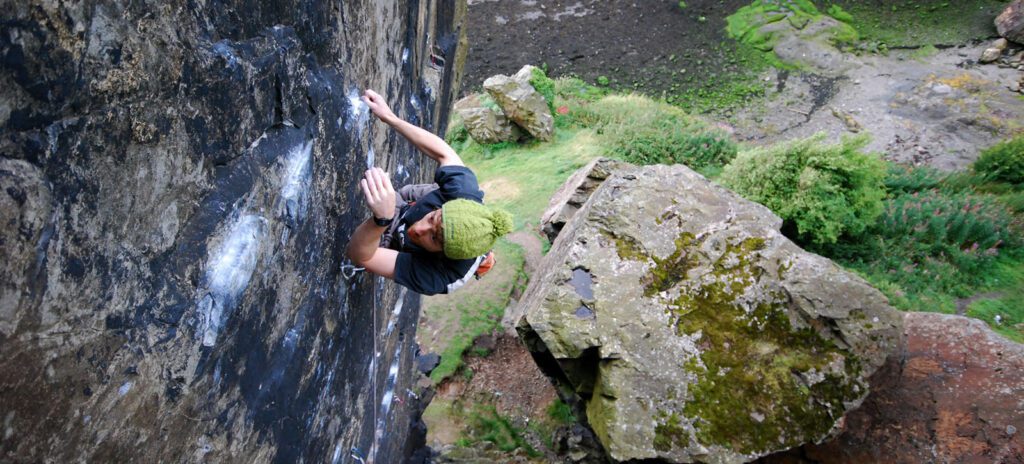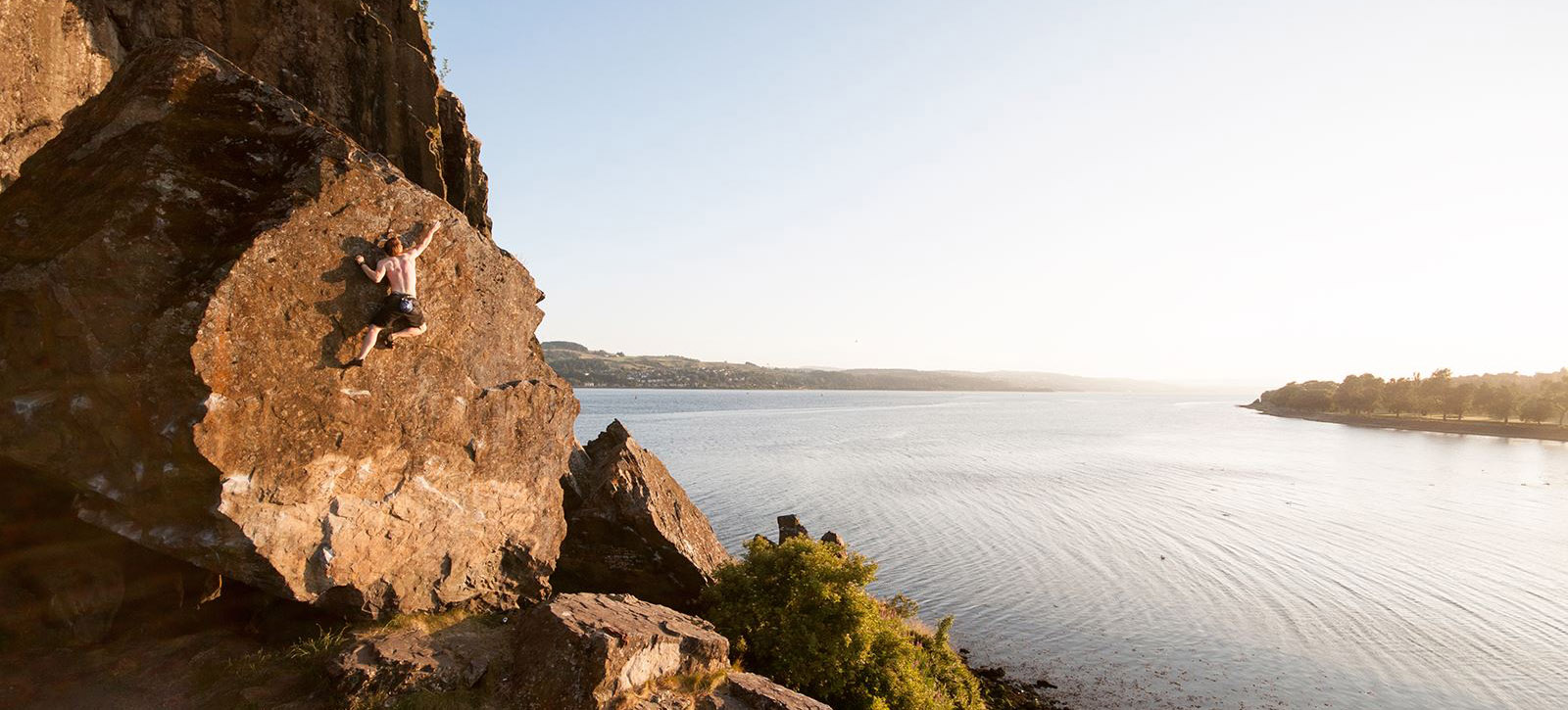08.09.20
Dumbarton Rock
As the brand new Dumby guide hits the shelves, co-author and TCA staff member John Hutchinson shares his personal connection to the Clyde’s iconic climbing venue.
Although the basalt outcrop of Dumbarton Rock is just a wee place, it’s had a big impact on the history of Scottish rock climbing, with a legion of rock climbers past and present falling under the spell of its offbeat climbing style and distinct sense of place. Since the early 1960s, ‘Dumby’ or ‘the Rock’, has acted as the lowland engine room of hard Scottish rock climbing, where the best climbers of each generation have left their mark on its soaring walls and monolithic boulders. While probably most frequented for its quality bouldering, it is the Rock’s imposing and overhanging north-west face which has provided the spectacular stage for two of its most iconic moments, with Dave ‘Cubby’ Cuthbertson’s first free ascent of Requiem (E8 6c) in 1983, and Dave MacLeod’s ascent of Rhapsody (E11 7a) in 2006, both breaking new grounds of technical difficulty while cementing Dumby’s reputation in the UK and abroad as a bastion of hard rock.
Getting to grips with Dumbarton Rock
My own connection with Dumby began soon after I moved to Glasgow in 2005 to begin university. Having picked up a weekend job at the outdoor store Tiso during my first year of study, I was quickly informed by some climber workmates that for Glasgow climbers, Dumby was the place to be. I still remember rounding the corner from the approach path for the first time and being slightly awestruck by the angular ship’s prow of the Eagle Boulder and the looming north-west face of the main crag above. Having started at the warm-up wall and been taken aback by the lack of friction offered by the smooth basalt, I gradually managed to find my feet and left that first session absolutely buzzing having managed to tick Toto – a classic 1980s Gary Latter testpiece that requires precise technique to unlock as opposed to brute strength. As a relatively new climber at the time, who could move well but lacked a bit of burl, this techie style of climbing suited me well and I saw Dumby as an ideal place where I could work my way through its vast array of boulder problems and routes to hone my skills. For some climbers, Dumby appears to be a bit of an acquired taste, but I was instantly hooked, both by its intricate style of climbing and its very particular sense of place as a semi-urban crag, where graffiti and broken beer bottles contrast with its often breath-taking natural beauty. This instinctive draw that I felt to the Rock and its wider landscape also coincided nicely with my burgeoning study of cultural geography, and I was delighted when my dissertation supervisor agreed that Dumby would be a perfect topic for my undergraduate thesis (a trick that I managed to repeat for my masters and PhD theses too).

As I got drawn more and more into climbing at the Rock as well as Scottish climbing more broadly, I would eagerly thumb my way through guidebooks, trying to soak up as much information as possible on the classic routes and venues. I was also drawn to the way that guidebooks seemed to abstract otherwise ‘blank’ rock into names, grades, routes, lines, and by association, the biographies of individual climbers – like a secret language you could learn. As a newbie at Dumby, I was fascinated by the stories of the exploits of previous generations and first ascents told by the keepers of the crag, not to mention the fact that the Rock’s wider written history as a military fortification stretches back 1500 years – that’s right, actual Vikings used to hang around the place and their ancestors sometimes still do, in the form of Stuart ‘Cobra’ Lyall. Though the Rock’s climbing history is much more recent than its military history, I think it’s equally fascinating, with generational waves of activity since the 1960s resulting in a rich and layered cultural heritage. With this in mind, in the new guide we have sought to recognise (and record) the value of Dumby’s climbing heritage by describing its storied climbing history in as much detail as possible, with a selection of previously unpublished historical photographs bringing life and a sense of dynamic movement to the written account.
Limited friction but limitless projects
Though an awareness of the Rock’s history will hopefully add some depth of feeling to your visits there, I’m afraid it won’t help you when getting to grips with its tricky climbing. As mentioned, Dumby’s smooth, angular basalt and the committing nature of many of its climbs means that on first acquaintance it can seem pretty full-on, with its lack of friction and marginal holds feeling a world away from the relative comfort of indoor climbing. However, these naturally cryptic qualities are offset by its super accessible nature and the simple fact that after experiencing an inevitable shut down, you can just come back to fight another day. It’s definitely a place that rewards patience and persistence, as the 1994 edition of Lowland Outcrops says: ‘Dumbarton isn’t a crag for the weak-fingered or weak-hearted but perseverance will strengthen both’. Because of this slightly paradoxical ‘accessible difficulty’, Dumby is a brilliant place to have hard projects on the go and refine your technique, as climbs go from feeling frustratingly desperate to satisfyingly doable. There’s also usually someone around who has the knowledge for a given problem which will save you a lot of time and frustration, as many of its climbs are very beta intensive. Another advantage of climbing at Dumby is the fact that it has the rare quality of possessing excellent trad, bouldering and sport climbing, which as well as providing variety allows you to develop a range of rock-related skills, whether that’s placing gear, rethreading sport anchors, or ‘keeping the heid’ while you’re high above your one bouldering pad and a nasty landing on one of its many highballs. You really couldn’t ask for a better local crag!
The irresistible pull of Dumby
On a personal level, Dumby has been the place where I’ve climbed my hardest routes and boulder problems, and having essentially learned to climb there I’ve always felt that it has provided me with a rock apprenticeship that has travelled well to other venues and rock types, whether that’s Spanish limestone, French Alpine granite or Australian sandstone. As well as the obvious physical (and mental) challenges the Rock offers, there’s also something ‘else’ more intangible that continually draws me back, whether it’s the reassuring feeling of sanctuary in movement, the simple enjoyment of being completely ‘present’ in a familiar place, or being part of a fantastic community of climbers that orbits the Rock. Spending a lot of time at Dumby (which is generally required to achieve anything there!) you really get to know it and notice it in all its moods – whether that’s the way the feel of the basalt varies subtly depending on the conditions on a given day, the natural quotidian shifts as the tides of the Leven and Clyde ebb and flow, or the moments of pure brilliance when the sunset suddenly turns the dark rock of the main face into a burning and brilliant ochre as if reminding you of its fiery volcanic birth. I can’t put it better than Dumby legend Andy Gallagher when reflecting on the undeniable pull and gravity of the Rock: ‘It’s one of those places that just gets right into your soul and your heart, and slowly but surely it keeps pulling you there, and pulling you there, and you’re back’.

The new Dumby Guide
Having spent countless days at the Rock over the previous 15 years, it has given me so much as a climber, but also just as a human trying to make sense of the world. I’m hugely grateful to have collaborated with the prolific guidebook writer John Watson of Stone Country Press in producing the first complete guide to the Rock, and it’s a great feeling to have contributed in some small way to the ongoing recognition of Dumby as a unique and hugely valuable climbing venue. As Glasgow climbers, we’re so lucky to have such a gem of a crag on the doorstep of our urban lives, where we can quickly escape the anxieties of the city and find some physical and mental space. I really hope that the new guide will help a whole host of climbers, whether new to the sport or highly experienced, discover some of Dumby’s magic and build a lifelong attachment to some very big and very ancient stones.
Get your copy
You could buy the new guide from various online retailers or you could buy it from the TCA shop. Every penny you spend with TCA helps to keep our walls open for you to climb in.
It costs £14.99 in the TCA Shop – available at The Newsroom only. Pass-holders get their usual 10% discount.
Share your Dumby stories and pics
Does Dumby have a special place in your heart? Share your pics and stories using #DumbartonRock and tag TCA. To get you psyched John has curated some of his favourite Dumbarton videos on YouTube – Watch Dumby Favourites or check out Chris Houston‘s classic compilations below:
All photos (including the header image of John H on Physical Graffiti) by Jonathan Bean except the one of Cobra (by John Hutchinson) and the one of John in profile (by Sam Scriven). For topos, directions and more great pictures visit: Dumby.info website / Dumby.info Facebook page



